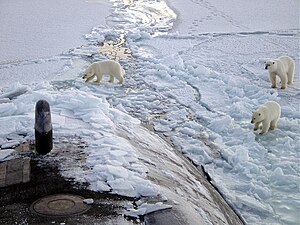 |
“This report chronicles how Arctic residents are dealing with rapid, climate change-induced impacts on their resources and traditional ways of life at the same time that new economic activity and opportunities are emerging — notably oil and gas, marine transportation, tourism and mining,” said Hayes, chair of the Alaska Interagency Working Group that commissioned the report. “It is imperative that we reduce redundancies and streamline federal efforts as we safely and responsibly explore and develop Alaska’s vast resources while preserving the region’s rich ecosystems that will sustain future generations.”
The report — Managing for the Future in a Rapidly Changing Arctic — is based on input from a wide range of Alaska stakeholders. In addition to recommending integrated management, the report recommends continuing high-level attention on the Arctic, strengthening state and tribal partnerships, encouraging more stakeholder engagement, undertaking more organized and inclusive scenario planning, and coordinating and potentially consolidating environmental reviews that are now being prepared by multiple agencies.
The report does not recommend new regulations or represent new policy decisions, but it does call for a review of the activities of over 20 federal agencies involved in the U.S. Arctic by the end of 2013 with an eye toward increased coordination and the elimination of duplication of efforts. Congress has entrusted the federal government with primary jurisdiction over nearly three quarters of the U.S. Arctic's land mass. In addition, the federal government has a special relationship with Alaska natives, including Alaskan tribes and native corporations
The report to the President was led by the Interagency Working Group on Coordination of Domestic Energy Development and Permitting in Alaska, with active consultation and assistance from the National Ocean Council and the Arctic Research Commission. Established by Executive Order 13580, the Interagency Working Group on Coordination of Domestic Energy Development and Permitting in Alaska includes 11 federal departments, agencies and executive offices.
The report also includes the launch of a new government web site, the Arctic Science Portal, by the Arctic Research Commission, which is chaired by former Alaskan Lieutenant Governor Fran Ulmer. This web portal will provide decision makers and other interested parties with easier access to scientific information about the Arctic. It includes information on topics such as sea ice, fisheries, oil spill research and many others. It can be accessed athttp://www.arctic.gov/portal/.
“This report to the President emphasizes the importance of using a science-driven, stakeholder-informed framework—one that takes into account the needs of functioning ecosystems—for making good decisions in the Arctic,” said John P. Holdren, President Obama’s science and technology advisor and Director of the White House Office of Science and Technology Policy, speaking on behalf of the National Ocean Council, which contributed to the report’s creation. “We must redouble our efforts to move forward on this path.”
“We are pleased to launch the Arctic Science Portal to help make science more accessible to decision makers and the general public,” said Fran Ulmer, Chair of Arctic Research Commission. “The report released today is extraordinarily important. It emphasizes the key role that science must play in making good decisions in the Arctic, and seeks to build on—and expand the successes achieved by the Interagency Working Group in coordinating across federal agencies, with all key stakeholders, and with the science community.”
The authors of the report engaged in discussions with many agencies and stakeholders in the Arctic to determine how the federal government might improve management processes and practices, reporting that diverse parties “agreed that management decisions in the U.S Arctic should seek to foster healthy economies, promote thriving cultures, and ensure sustainable ecosystems—an encouraging consensus.”
“Based on input from a wide range of stakeholders, this report shows how applying integrated Arctic management principles can help us make well-informed decisions in the Arctic,” said Hayes. “The key is taking a holistic approach and putting a premium on interagency coordination, the traditional knowledge of Native communities, and having a fuller understanding of landscape-level sensitivities and impacts. Because Congress has given the federal government such a major role in the U.S. Arctic, we have a responsibility to improve our coordination, planning, and outreach as we partner with the State of Alaska municipalities, tribes, Native corporations, and other parties that have a stake in the region.”
A copy of the report is available here.




